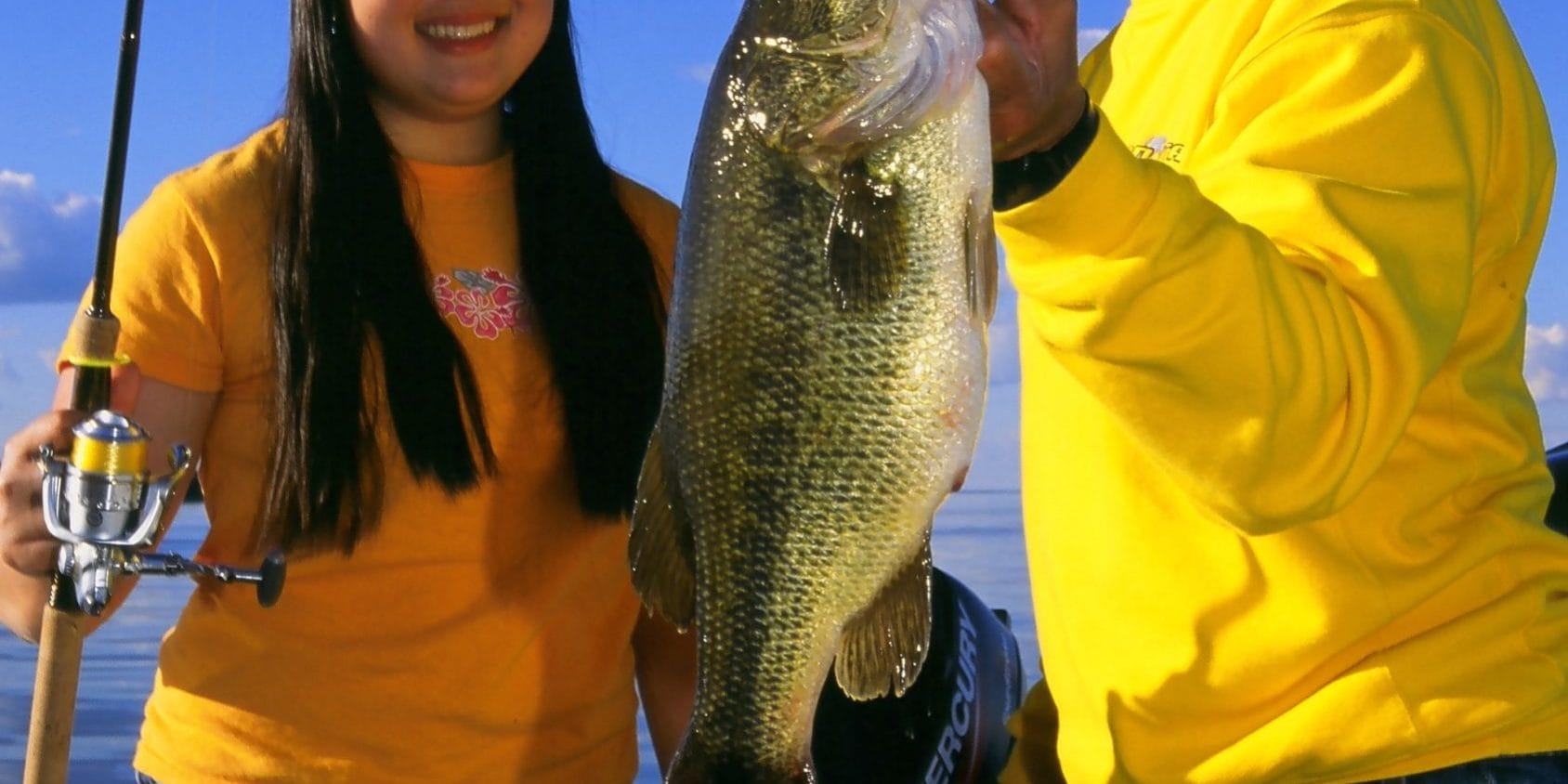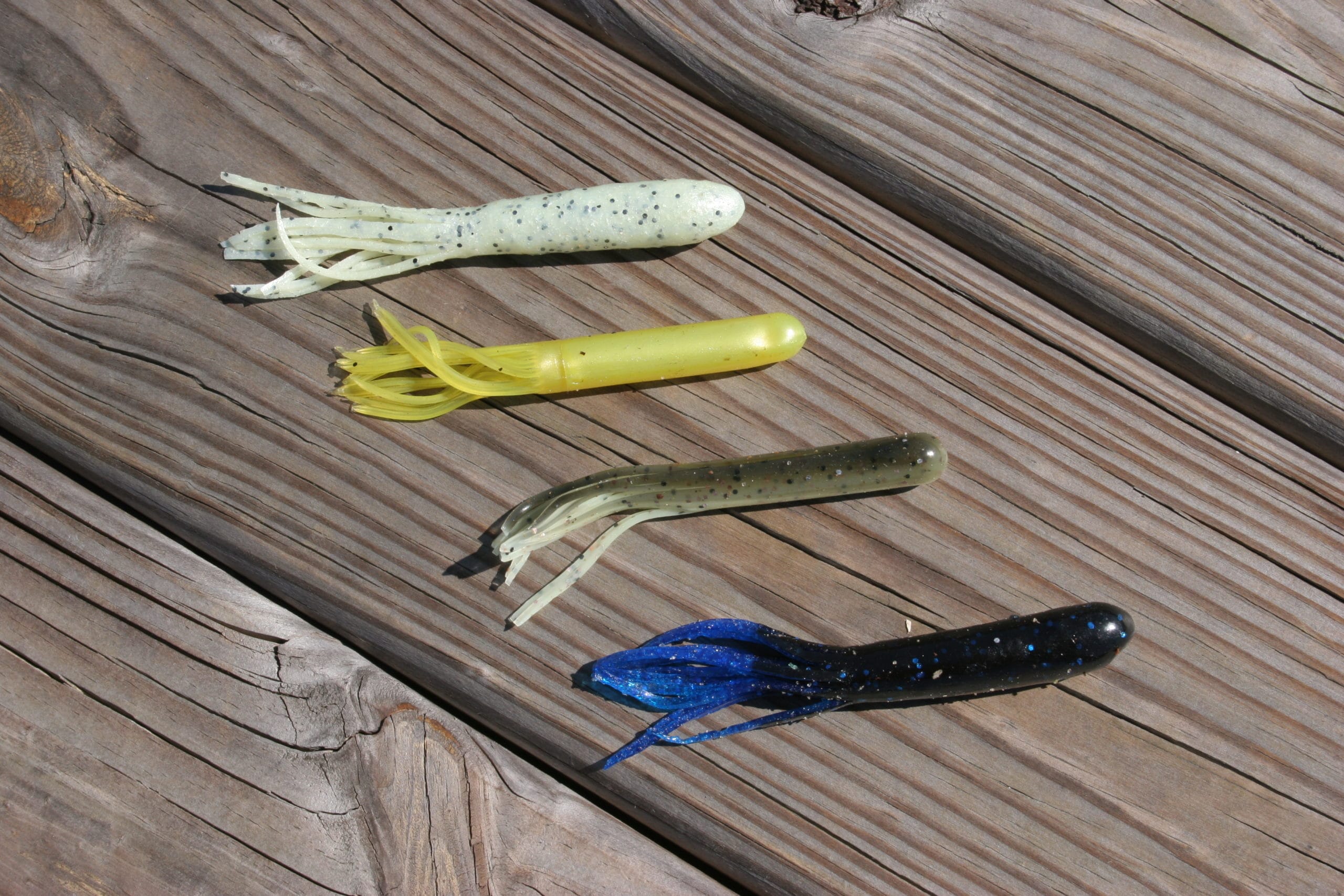by Bob McNally
Few anglers have the focused concentration of a deep-water walleye fisherman ogling a fathometer over a likely hot spot.

Ted Takasaki, with daughter Kristi, shows a bass caught backtrolling a jig. This is a proven technique for walleyes that also works great on bass.
“But what’s really amazing is how many bass are caught by good walleye fishermen,” says champion tournament walleye angler Ted Takasaki, former president of Lindy Tackle in Brainerd, Minnesota. “I regularly catch largemouths and smallmouths when targeting walleyes, because fish are fish, and big bass and walleyes often hold on similar structures and can be tempted into striking using many of the same lures and baits.
“I fish for walleyes all over the country, and I catch largemouth and smallmouth bass using the same techniques, in the same waters and structures, where I find walleyes. Spotted bass, big crappies, pike, muskies, striped bass and other fish are caught using walleye tactics, too.”
Here are five of Ted’s favorite walleye tactics that also score well on bass.
Backtrolling
One of Ted’s favorite walleye fishing methods that’s also deadly for bass is backtrolling. This innovative, slow-trolling tactic is basically a boat control method that allows anglers to place lures and baits on key structure configurations with pinpoint and deadly fishing accuracy. Most important, it’s a remarkably effective angling procedure that produces big numbers of fish, especially finicky deep or suspended bass.
Backtrolling is not merely running a boat in reverse. Rather it’s a boat control method that can be employed various ways to offer complete control over boat position, course, speed and lure or bait presentation. If you can’t put a boat where you want it and keep it there, either your equipment or your techniques are not what they should be—at least not for persnickety fish, says Ted.
Because backtrolling is such a precise, and slow, lure-bait presentation method, it enables an angler to map or learn vital features about deep structure that rarely are shown on charts.
Because of the nature of backtrolling, tiller-handle outboards are best, and stern-mounted electric motors are preferred. Tiller-handle outboards and electric motors are more responsive to tight turning, stopping-and-going, and slow idle speeds needed for precise contour structure fishing. Also, a boat moved stern first allows for instantaneous, tight turning on a structure—much more responsive than a boat trolling forward.
Vertical Fishing
Because backtrolling is essentially a vertical, bottom presentation method, lures and baits conducive to the technique are best. Jigs and heavy spoons that make constant contact with bottom are good. Such lures really shine during backtrolling when fished in a lift-and-drop method, or vertical fishing. When done carefully, while watching a depthfinder closely, backtrollers can jig lead heads and spoons right up vertical ledges and even down through sparse flooded timber and stump fields.
Bottom Bouncers
Another of Ted’s favorite walleye tactics that also tempts plenty of bass is fishing bottom bouncers.
The beauty of a bottom bouncer is that it keeps a lure or bait in contact with bottom, yet it resists fouling like few other rigs. Further, since most bottom bouncers are heavy, they can be used for quick trolling when the need for speed is great, as when fish are scattered and anglers have to cover water fast to find them.
A bottom bounder is an ingenious rig, though it’s deceptively simple in design. It’s merely a V-shaped piece of stiff wire with the longest arm of the “V” having a chunk of lead attached. The 1/2- to 3-ounce weight is positioned about mid-way along the wire arm. The wire arm not having a weight is usually shorter than the leaded wire arm, and this short wire arm usually has a barrel swivel or snap swivel for attaching a leader that connects to a natural bait, crankbait or soft plastic lure. At the point of the “V” is where the fishing line is tied.
This is the ultimate bait and lure presentation when trolling or drifting in wind or current and looking for bass on submerged stump flats, riprap, around concrete dam slabs, bridge abutments—anywhere anglers must make contact with bottom, yet have their lures above snags. It’s better than some other bottom fishing rigs because a bottom bouncer is designed for fast fishing that covers water until bass are located.
Slip Floats
Ted has learned he can present lures in some bass-holding areas most effectively by using delicate, sensitive, but very simple-to-use modern fishing floats, which are widely used by walleye anglers around the country.
Ted likes to rig a large Thill Center Slider float onto his fishing line, then tie on a 1/4-ounce Lindy Fuzz-E-Grub jig. He positions his boat on the up-current or up-wind side of a dock, and then casts the compact float-lure rig near a piling. When the float-and-lure rig hits the surface, the jig spirals down enticingly, pulling fishing line through the float quickly as it falls. Fitted onto the fishing line above the float is a small knot called a float stop, designed to jam against the top of the float. This keeps the fishing line from running through the float any father, and thus halts the fall of the lure and controls the depth.
The same slip-float rig and fishing technique also works great when working deep pockets in weed beds, like lily pads, floating dollar grass, hyacinths and hydrilla. A weedless plastic worm is excellent in this situation.
Finesse Fishing In Wood
Flooded timber, blow-down trees, stumps and brush can be full of walleyes, as well as bass. If fish are not particularly aggressive, Ted prefers to finesse them into striking using a jig-and-minnow technique employed by many walleye anglers throughout the North.
“It’s important to use a jig just heavy enough to cast and work the depth water,” Ted explains. “Often just an 1/8-ounce tube jig is needed, but sometimes a 1/4-ounce is good, depending on the depth and how much wood cover is present. In real brushy, tangled water, a weedless lightweight jig, like a slip-rigged tube lure, is needed. But in large stump or flooded logs in 8 or 10 feet of water, a 1/4-ounce or even 3/8-ounce weedless jig can be used.“The technique is to slowly swim the jig around the cover. It takes full concentration, and a lot of feel is needed, so a sensitive graphite rod with a cork handle is best. Braided line also is helpful to feel the lure in wood, and to detect strikes. Plus hook sets are sure and braided line is very abrasion-resistent.”
Ted says when an angler feels a deep branch or tree trunk with a tube jig, he should pause the retrieve and jiggle the lure a moment or two. Often a fish holding there can be coaxed into biting with such a retrieve, but you’ve got to “play the branches.” When fish are very finicky, a slow fall rate is desirable in wood, which can be achieved by using a small jig head with a big, buoyant plastic body.
Bob McNally’s best-selling bass book is Bass…In Depth. The 288-page, 26-chapter work has 200 detailed illustrations and exciting photographs, and is a comprehensive guide to bass fishing. Signed copies are available for $16.95 from McNally Outdoor Productions, 1716 Bayside Blvd., Jacksonville, Fla. 32259.
The Union Sportsmen’s Alliance website is designed to provide valuable articles about hunting, fishing and conservation for members of AFL-CIO affiliated labor unions and all sportsmen and sportswomen who appreciate hunting and fishing and want to preserve our outdoor heritage for future generations. If you would like your own story and experience from the outdoors to be considered for our website, please email us at [email protected].






